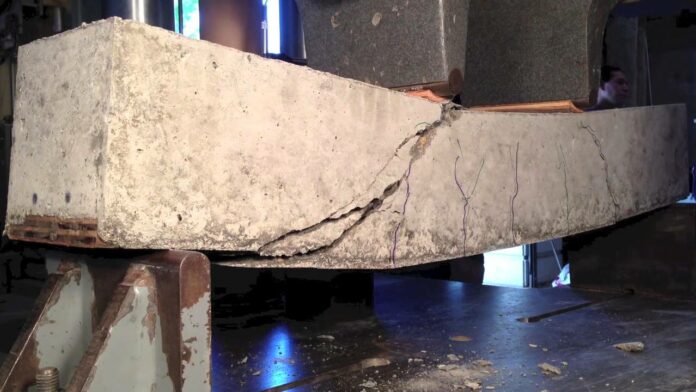This paper presents an overview of solidification of reinforced concrete structures. Structural elements normally are designed to suit the various types of loadings. However many civil structural elements, reinforced concrete beams as an example are often required to be upgraded or strengthened due to increased load requirements. In this paper, strengthening by using sprayed concrete, ferrocement, steel plate and fibre reinforced polymer (FRP), and the methods of applying these materials are reviewed.
Experimental results of three beam specimens that were carried out by the authors are also reported to evaluate the behaviour of strengthened reinforced concrete beams. The experimental results showed that strengthened beams using steel plate and FRP had higher failure load compared to un-strengthened beam. Results also indicated that FRP laminate was more effective in increasing the beam strength compared to steel plate.
Introduction to Solidification
Solidification of reinforced concrete structures is an important task in the field of structural maintenance. The aim is to increase the capacity of an existing structural element.
Why is solidification necessary?
This work is very significant since many civil structures are no longer considered safe which can be due to increased load specifications in the design codes, overloading, under-design of existing structures or to the lack of quality control.
In order to maintain efficient serviceability, older structures must be repaired or strengthened so that they can meet the same requirements demanded of structures built today and in the future. It is also becoming both environmentally and economically preferable to repair or strengthen the structures rather than to replace them totally, particularly if rapid, effective and simple strengthening methods are available.
MATERIALS AND METHODS OF SOLIDIFICATION R.C. C. STRUCTURES
Several methods and materials had been reported to be viable for strengthening existing r.c. structures. These include many materials, but we have focused on sprayed concrete, ferrocement, steel plates and fiber reinforced polymer.
Sprayed Concrete
It is one of the oldest materials and the most common techniques of repairing and strengthening of reinforced concrete structures. Sprayed concrete has been used in that field for almost for more than 90 years. The technique of strengthening of reinforced concrete beam by using sprayed concrete. There are two processes for applying sprayed concrete.
The dry mix sprayed concrete as sprayed concrete in which most of the mixing water is added at the nozzle, and wet mix sprayed concrete as sprayed concrete in which the ingredients, including water, are mixed before introduction into the delivery hose, is normally added at the nozzle.
Both dry mix and wet mix sprayed concrete are used in concrete repair/strengthening work, but the use of dry mix sprayed concrete is more common.
Ferrocement laminates
Ferrocement is a type of thin composite materials made of cement mortar reinforced with uniformly distributed layers of continuous, relatively small diameter, wire meshes. Ferrocement, being of the same cementitious material as reinforced concrete (r.c.), is ideally suited as an alternative strengthening component for the rehabilitation of r.c. structures.
The ferrocement laminate possesses higher tensile strength to weight ratio and a degree of toughness, ductility, durability and cracking resistance that is considerably grater than those found in other conventional cement based materials. The use of ferrocement proper in repair was first introduced in the early 1980s mainly as relining membranes for the repair of liquid retaining structures, such as pools, sewer lines, tunnels, etc.
For flexural strengthening, the ferrocement laminates were cast onto the soffits (tension face) of the beams without any change in width of the beams, while in shear strengthening the ferrocement laminates were formed onto the three exposed faces of the beams, except for the top compression face. Before placing the ferrocement laminates proper surface preparation should be ensured.
Steel plate
Steel plate is one of the most common materials for strengthening of R.C.C. structures. It is very effective for increasing the flexural and shear capacity of reinforced concrete beam. Strengthening by steel plate is a popular method due to its availability, cheapness, uniform materials properties (isotropic), easy to work, high ductility and high fatigue strength. Investigations into the performance of members strengthened by this technique were started in the 1960s. This method had been used to strengthen both buildings and bridges in different countries. However, the most common form of plating is to glue steel plates to the tension faces of beams. In this position, the plate is at its furthest extremity from the compression region and, as a result, the composite flexural action is at its maximum. Furthermore, the composite action between the plate, glue, and concrete will be maintained until failure.
However the effectiveness of this method depends on the surface preparation and bonding methods between existing beam and steel plates. Thus, the surface preparation of existing beam as well as steel plate has to be carried out effectively. The roughening process of the beam surface before placing the plates. The roughening process is carried out using a mechanical grinding until the laitance was removed and the surfaces were then brushed and cleaned thoroughly with acetone. The bonding faces of the steel plates can also be sand-blasted and then cleaned with acetone. After surface preparation epoxy adhesive is placed on the roughened surface and then steel plate is positioned on top.
Fibre reinforced polymer (FRP)
Using fibre-reinforced-polymer (FRP) for strengthening of reinforced concrete structures is also effective due to its high strength to weight ratio. The FRP materials had mechanical and physical properties superior to those of steel, particularly with respect to tensile and fatigue strengths, and these qualities are maintained under a wide range of temperatures.
Several fibre reinforced polymer (FRP) systems are now commercially available for external strengthening of concrete structures. The fibres commonly used in these systems include glass, aramid, and carbon and they are available in many forms such as pultruded plates, uniaxial fabrics, woven fabrics and sheets.
EXPERIMENTAL WORKS
A total of three beams, each 2300 mm long, 125 mm wide, and 250 mm deep, were fabricated and tested. One beam was left un- strengthened to act as the control beam (A1), one beam was strengthened with steel plate (B1) and other beam was strengthened with CFRP laminate (C1). For all strengthened beams, the length of the bonded plate was maintained at 1900 mm, which covered almost the full-span length of the beams.
Results
Plate 1 shows the failure modes of control beam (A1), steel plate strengthened beam (B1) and CFRP laminate strengthened beam (C1).

It was seen that the control beam without strengthening plates (A1) showed the traditional flexural and ductile failure. Further, steel plate (B1) and CFRP laminate (C1) strengthened beams failed by plate debonding with brittle manner.
Table 1. Test results
| Speci men | 1st Crack Load in kN (% Increase over control) | Failure Load in kN (% Increase over control) | Failure mode |
| A1 | 14 | 80.59 | Flexural |
| B1 | 35 (150) | 104.3 (29) | Debonding |
| C1 | 27 (93) | 123.9 (54) | Debonding |
However, the experimental failure loads recorded by all the beams are shown in Table 1. The results showed that the failure loads of beams B1 and C1 were respectively 29% and 54% higher than beam A1
CONCLUDING REMARKS
Solidification of reinforced concrete structures is one of the most important tasks normally associated with the maintenance of concrete structures. A number of strengthening materials are available in the market. These include sprayed concrete, ferrocement, steel plate and fibre reinforced polymer (FRP). In general the use of steel plate and FRP laminate are preferable due to their several advantages such as easy construction work, minimum change in the overall size of the structure after plate bonding and less disruption to traffic while the strengthening work is being carried out. Both of these materials are effective to increase the flexural strength of r.c. beams. From the preliminary experiment work carried and it can be seen that FRP laminate is more effective in increasing the flexural capacity of r.c. beam compared to steel plate.
Authored by;

About the author;
The author has more than three decades of experience in multi-disciplinary transactions ranging from industrial projects to real estate development projects. Expertise in planning, undertaking demand assessment studies, transaction services, project execution, business development, etc. including marketing strategies based on technical market analysis, feasibility studies, program requirement derivation and fund and investor sourcing.
Almost 7 years experienced senior professional with project & construction management expertise in large projects for IT, Commercial, Industrial, residential sectors, etc. and more than 18 years of heavy engineering industrial projects like Fertilizers, Oil & Gas, Petrochemicals, etc.

